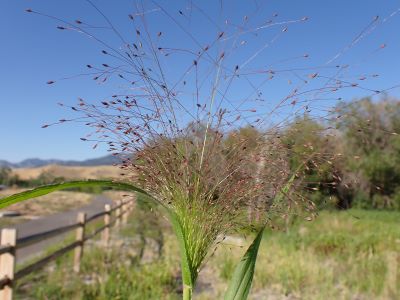Witchgrass (Panicum capillare)
By Tim Seipel, Cropland Weed Extension Specialist, Montana State University
Introduction

Photo; Matt Lavin, MSU
Witchgrass (Panicum capillare) was very conspicuous across Montana later in the growing season of 2023 and garnered a lot of comments and questions. Witchgrass is an annual warm season grass that is native to most all temperate North America, including Montana. As a C4 warm season grass it germinates later than some other annual grasses in Montana and is most obvious in August and September.
Identification and Biology
Witchgrass is variable and can grow from four inches to two feet tall.Leaf blades can be lax (prostrate) to ascending and often look wider than other annual grasses we commonly encounter. The leaf sheath margins overlap, and look rolled over each other. The ligule, where the sheath and leaf blade meet, is hairy, and the leaf sheath and blade have many relatively long hairs that are often perpendicular to the stem. When witchgrass flowers it becomes very noticeable and is found lining roadsides and in other disturbed habitats. The inflorescence, or seedhead, is a big, open, airy panicle (think big, tufted ball). The panicle can be large, ranging from a few inches to a foot in diameter, and forms in late July and August. There is one floret on the tips of panicle branches, and the seeds are small and round. The inflorescence breaks off in the autumn and tumbles, spreading the seed.
Ecology and Impacts

Photo; Matt Lavin, MSU
Witchgrass is a native plant that colonizes disturbed areas. In many cases this species does not need to be controlled. However, witchgrass can be weedy in home landscapes, warm season annual crops, and in irrigated crop areas in Montana. This species is more problematic in the eastern and Midwest United States where summer precipitation is more abundant. Witchgrass is often not problematic in cool season cereals like winter and spring wheat because cool season cereals grow early in the season, tiller, and form a dense canopy, outcompeting witchgrass that germinates later in the growing season. Witchgrass abundance varies in Montana from year to year and 2023 it was abundant because of available soil moisture and summer precipitation. In years with low soil moisture and fewer summer precipitation events witchgrass is less abundant.
Management

Photo; Matt Lavin, MSU
If witchgrass management is necessary, there are different tactics that can be employed in different situations. Preventing seeds from forming is always a priority for annual grass management. In orchards, yards, and gardens, mowing, tilling, or hand pulling is effective because the root system is small and fibrous and easily destroyed. Be sure to continue to monitor plants and mechanically remove any vegetation before the seed ripens. Several herbicides are available to manage witchgrass as well. For example, Group 1, ACCase inhibitor grassy herbicides can provide control in croplands, and a range of other herbicides are available for other situations.
Further Information
For more information about this month's weed post, contact Associate Extension Specialist Noelle Orloff. Past posts are available in the Monthly Weed Post Directory.
This weed post is also available as a printable PDF (279 KB).
